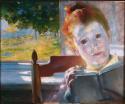Art Of The Day Weekly
#438 - from 7 July 2016 to 7 September 2016
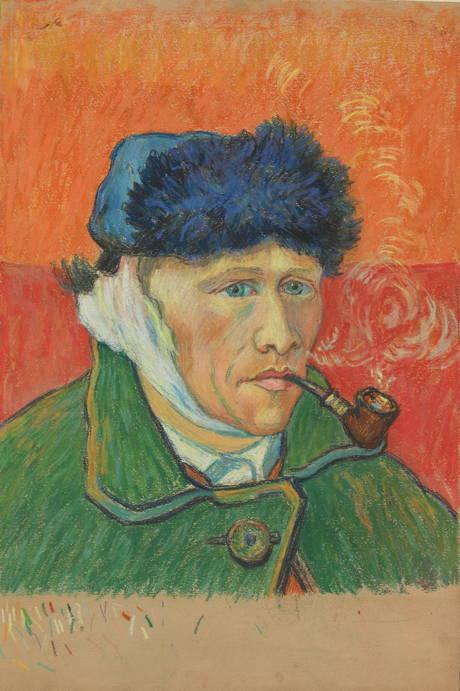
Emile Schuffenecker, Man with a Pipe (after Van Gogh's Self-Portrait), ca. 1892-1900, chalk on paper, Van Gogh Museum, Amsterdam (Vincent van Gogh Stichting).
Our next issue will appear on 8 September 2016. Have a nice summer!
IN THE AIR
Van Gogh, in praise of madness
AMSTERDAM – Madness and art are often in twine. We can count on such a number of depressive, paranoid or suicidal artists, starting with Piero di Cosimo, going on to Camille Claudel and Nicolas de Staël, and beyond. In this galaxy, Van Gogh has a special place, turned into a myth by Hollywood and Kirk Douglas. In December 1888, while he was hosting Gauguin at his home in Arles, a terrible dispute broke out between the two men and Van Gogh cut off part of his ear lobe and offered it to a prostitute. Two years later, in Auvers-sur-Oise, he committed suicide with a gun. This period was marked by ostracism (as a petition by residents of Arles asked he be interned), hospitalisation (in particular at Saint-Rémy-de-Provence) and ’introspection (in his correspondence, he wonders about his illness). But it is also his most productive. Over a period of thirty months, he frenetically painted some 200 paintings! This exhibition opens this part of his life by presenting the works of that period, in particular his very last work, Tree Roots. They resemble tortured synapses. New elements, such as letters and documents kept at the Arles municipal archives will be shown. Was he a manic-depressive, epileptic, a victim of his high consumption of absinthe or did he suffer from porphyria, like King George III of England? Specialists will hold a symposium on 15 September to try to finally untangle the knot of Van Gogh’s brain.
• On the Verge of Insanity. Van Gogh and his Insanity at the Van Gogh museum from 15 July to 25 September 2016.
10 EXHIBITIONS ACROSS EUROPE
Van de Velde, the forgotten Dutchman
AMSTERDAM - Adrien van de Velde died three years after Rembrandt, and at the time he was almost just as famous. But it diluted little by little over time and today the spotlight is being focused on an artist who is practically unknown. This virtuoso of landscapes, from a family of artists, died very young, at the age of 35. But he had time to leave behind suggestive views of hills and seascapes. He was also a very gifted painter of animals, and dogs, sheep, cows and above all cats create a happy comedy under his paintbrush.
• Adriaen van de Velde at Rijksmuseum, from 24 June to 25 September 2016.
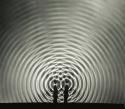
Berenice Abbott, Interference Pattern, 1958-61. © Berenice Abbott/Commerce Graphics, courtesy Howard Greenberg Gallery, NY.
Abbott, a polymorphic photographer
BERLIN - She is one of the myths of XXth century photography. This young American woman, when in Paris, developed a passion for Eugène Atget and contributed to the safeguard of his work. As a photographer in her own right, Berenice Abbott (1898-1991) worked for six decades, and left her mark in the careful observation of urban transformation, in Paris and New York. Maybe she saw too much. In search of essential purity she ended her career, like Roman Vishniac, by becoming a specialist of scientific photography.
• Berenice Abbott at Martin Gropius Bau, from 1 July to 3 October 2016.
Saving Besnard
EVIAN - His CV is as long as one’s arm: he was director of Villa Medicis in Rome, director of the Ecole nationale des beaux-arts in Paris, a member of the Académie française and was buried with all the national honours. That excess of honour followed him to his tomb: Albert Besnard (1849-1934) today is totally forgotten. This retrospective tries to understand why. It shows a gifted artist capable of drawing up Oriental and picturesque scenes, family portraits, alluring ladies. His work is always well finished and very lively. But his academic vein was disliked by the avant-gardes that came after him, and that anathema still accompanies his reputation.
• Albert Besnard, modernités Belle Epoque, at the Palais Lumière, from 2 July to 2 October 2016.

Joaquín Sorolla, The White Boat. Jávea, 1905, oil on canvas, 105 x 150 cm. Private Collection. © Madrid, avec l’aimable autorisation de Blanca Pons Sorolla
Sorolla, a triumph in Paris
GIVERNY - He is without a doubt the greatest Spanish impressionist and his links with Paris helped confirm his reputation. This exhibition shows it by tracing the Parisian chronology of Joaquín Sorolla (1863-1923). After a first stay in 1885, the Spanish painter from Valencia was awarded a gold medal at the Universal Exhibition in 1900. He was then crowned by a retrospective at the galerie Georges Petit in 1906, after which he received the French Légion d’Honneur (Legion of Honour). He was recognized for his beach scenes and then became one of the main portrait artists of the bourgeoisie of the Belle Epoque.
• Sorolla, un peintre espagnol à Paris, at the musée des Impressionnismes, from 14 July to 6 November 2016.
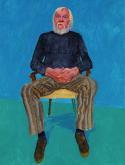
David Hockney RA, John Baldessari, 13th-16th December, 2013. Acrylic on canvas. 121.9 x 91.4 cm. © David Hockney. © Photo: Richard Schmidt.
Hockney, drunk with colour
LONDON - When Lucian Freud passed away, David Hockney (born in 1937) took over the role of most famous British painter. After returning to his native Yorkshire to dedicate himself for a while to landscapes, he caught the virus of portraits in the midst of a revolution he knew well, Los Angeles. Artists like John Baldessari, gallery owners like David Juda, members of the aristocracy as well as of the jet set Jacob Rothschild are among the nearly 80 persons to have been immortalized in his violently coloured paintings.
• David Hockney RA at the Royal Academy of Arts, from 2 July to 2 October 2016.
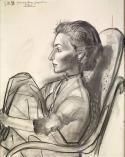
Pablo Picasso, Jacqueline aux jambes repliées, 1954. Private collection © Succession Picasso / 2016 ProLitteris Zurich / Photographie Claude Germain
The ultimate Picasso
MARTIGNY– She was his last muse, bid him goodbye at the castle of Vauvenargues (where he is buried) and, finding his absence unbearable, committed suicide 13 years after his demise. Jacqueline Roque (1926-1986) is inseparable from Picasso’s last period, the one of a relentless master who at more than 75 years old, kept a certain greeness, a creativity and surprising energy. From Cannes to Mougins, Jacqueline is often at the center of his compositions, which also explore the relationship to the great masters (Delacroix, Velázquez and Poussin).
• Picasso, l’œuvre ultime. Hommage à Jacqueline, at the fondation Gianadda, from 18 June to 20 November 2016.

Emilio Isgrò, Manutian shadows, 2014, 155 x 50 x 63 cm, mixed media on book mounted on board. Private collection.
Isgrò the iconoclast
MILANO – For half a century he has been methodically erasing all words in the books that fall into his hands, from the Enciclopedia Treccani (the equivalent of the Encyclopedia Britannica) to the complete works of Manzoni (the Italian Victor Hugo). Emilio Isgrò (born in 1937) turned this iconoclastic practice into a form of visual poetry. Also a novelist and a poet, he looks behind words and forms (like in photos of Mao, famous paintings by Hayez or Raffaelo, the public debt) to question the concepts of identity, authority and censure. Aside from the Palazzo Reale, the exhibition is also held in the Gallerie d’Italia and Casa del Manzoni.
• Emilio Isgrò at Palazzo Reale, from 29 June to 25 September 2016.
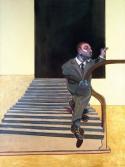
Francis Bacon, Portrait of a Man Walking Down Steps, 1972, oil on canvas, 198 x 147.5 cm. Private collection © The Estate of Francis Bacon. All rights reserved, DACS 2016. Photo : Prudence Cuming Associates Ltd.
Bacon, a Monegasque by adoption
MONACO - We all know his links with Ireland, where he was born, with London where he worked and haunted the pubs in Soho, Paris where he underwent the Picasso shock in 1927, at age 18 or Spain, where he died in Madrid in 1992. But Francis Bacon also had lasting links with Monaco. A problem gambler, he was mainly attracted by the casino and he settled there right after the war until the beginning of the fifties. That is where he painted his first Popes, inspired by the Innocent X by Velázquez, which would be one of his most famous motifs. Through some sixty works of art the exhibition examines the subject from all sides, two years after the creation in Monaco itself, of the Francis Bacon MB Art Foundation.
• Francis Bacon, Monaco et la culture française at the Grimaldi Forum, from 2 July to 4 September 2016.

Moke, The Orchestra in the Forest, 1999. CAAC – The Pigozzi Collection, Geneva. © Moke. Photo : Maurice Aeschimann. Photos (animaux) : © Shutterstock / © Biosphoto.
Animal voices
PARIS - We have all heard the croaking of frogs, the squawk of crows or the clear whistle of the blackbird in the spring. But then, city dwellers are increasingly disconnected from nature. That is why the Fondation Cartier is offering an accelerated initiation to whistles and grunts, through the work that bio-acoustics specialist Bernie Krause has developed for decades by recording the sounds of the inhabitants of woods and plains. This is a good opportunity, with the paintings, installations and scientific photographs put in to enrich the exhibition, to remind everyone that our own survival depends on that of the animal world that surrounds us.
• Le grand orchestre des animaux at the Fondation Cartier, from 2 July 2016 to 8 January 2017.
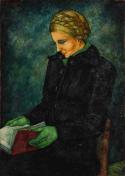
Jean Martin, Woman with Green Gloves, 1941, oil on canvas, 94 x 66 cm. Private collection, photo: Photo-France / Patrick Chevrolat.
Martin is back
ROUBAIX – An apostle of the ill-known creators of the XXth century, la Piscine pulls out of oblivion Jean Martin (1911-1996). Of a modest background and with a rather ordinary name, the most common in France – he was one of the artisans of the renewal of sacred art. He held a gallery in the most religious district of Paris, Saint-Sulpice, and he went back to ancestral techniques such as tempera. Martin also used his science of décor for movies, television and theatre. He was close to the realism of Fougeron, and nourished a long friendship with Marc Barbezat, the founder of the review l'Arbalète and the first editor of Jean Genet.
• Jean Martin, de l’atelier à la scène, at la Piscine, from 25 June to 9 October 2016.
OPENINGS OF THE WEEK

LUCY'S IRIS
7 July 2016 - ROCHECHOUART - Musée d'art contemporain
A glimpse at women artists in Africa (detail: Safaa Erruas)


